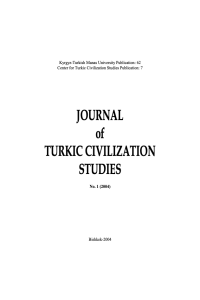Öz
This article focuses on the relations between the Uighur state of the period 744 to 840 and China under the Tang dynasty and their mutual impact. The article covers four aspects of the relationship: the military, diplomatic, economic, as well as alliances through marriage. Although the influence was mutual, that from China on the Uighur state was greater than the other way around. This was hardly surprising given the imbalance between the size of the populations and age of the cultures. Moreover, not all this influence from China was specifically Chinese, since a major element was in the form of Manicheism, which is Persian in origin and not a religion the Chinese liked.
The Uighur state of 744 to 840 was among the earliest established by the Turkic peoples and forms a major milestone in the development of Turkic civilization. At that time the Uighurs controlled a vast territory, their capital city being Karabalghasun, which was located on the High Orkhon River in what is now the Republic of Mongolia.2 They were a warlike people, among whom the horse was a particularly important cultural icon for a range of reasons, including above all its use for transport.
Kaynakça
- Uygur-Tang Relations, 744-840’, Central Asian Survey Vol. 19, No. 2, June 2000, pp. 223-34.
Öz
This article focuses on the relations between the Uighur state of the period 744 to 840 and China under the Tang dynasty and their mutual impact. The article covers four aspects of the relationship: the military, diplomatic, economic, as well as alliances through marriage. Although the influence was mutual, that from China on the Uighur state was greater than the other way around. This was hardly surprising given the imbalance between the size of the populations and age of the cultures. Moreover, not all this influence from China was specifically Chinese, since a major element was in the form of Manicheism, which is Persian in origin and not a religion the Chinese liked.
The Uighur state of 744 to 840 was among the earliest established by the Turkic peoples and forms a major milestone in the development of Turkic civilization. At that time the Uighurs controlled a vast territory, their capital city being Karabalghasun, which was located on the High Orkhon River in what is now the Republic of Mongolia. They were a warlike people, among whom the horse was a particularly important cultural icon for a range of reasons, including above all its use for transport.
Kaynakça
- Uygur-Tang Relations, 744-840’, Central Asian Survey Vol. 19, No. 2, June 2000, pp. 223-34.
Ayrıntılar
| Birincil Dil | İngilizce |
|---|---|
| Konular | İletişim Çalışmaları |
| Bölüm | Araştırma Makalesi |
| Yazarlar | |
| Yayımlanma Tarihi | 30 Haziran 2004 |
| Yayımlandığı Sayı | Yıl 2004 Cilt: 1 Sayı: 1 |
Journal of Turkic Civilization Studies © 2022 by TUAUM is licensed under Attribution-NonCommercial 4.0 International
Journal of Turkic Civilization Studies by TUAUM is licensed under Attribution-NonCommercial 4.0 International


